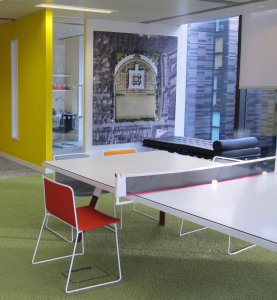
To get a handle on what running an architecture practice is really like, we talked to Edinburgh-based architect, Simon Laird.
His specialist practice, Simon Laird Associates, provides a range of architectural, interior design and consultancy services. All following his mantra: ‘designing for real life’.
How long have you been in business?

15 years. I set up Simon Laird Associates (SLA) in 2003.
How soon after qualifying did you set up your own practice?
20 years. But I’d been working as a partner in another firm before I set up on my own, so technically, I’d been self-employed for a number of years before that.
Why? What made you take the plunge?
It was a case of divergence.
As I was becoming more committed to understanding how people use buildings, the firm I was a partner in was going the other way.
It was a difficult decision. But in the end, I just felt I had to go and do something which gave me the freedom to honestly respect the drivers in my professional philosophy.
And that is?
To understand people. To understand buildings. And to produce solutions that help people use buildings effectively.
Setting up on my own gave me more control and the chance to put my professional philosophy into practice.

Talk us through the steps you’ve taken to get to this point? What was the first thing you did?
I set up a studio at home. Trouble is, when you leave a firm, there are restrictions on working for clients you already have. So I had no clients to start with, which was tough.
However, one of the things I’d felt really constrained about before I started up on my own, was not being able to do research.
That first year, I got into research into building use for the British Council for Offices, working on their handbook for best practice in the development and construction industries.
That gave me a bit of a profile. And after that things began to flow. Just small projects to start with. Then in about year 3, after running a series of seminars based on my research, I got my first, decent sized client. At that point, I took on my first assistant.
That was 12 years ago and we’re now a team of between 3.5 and 4.5 people, depending on our workload. We’ve got a huge variety of projects on and clients ranging from a distiller to a church.
About 3 years ago, I also started teaching one day a week at Edinburgh Napier University. Which I love. It’s great to be able to combine practice with research, with writing and with teaching. As well as designing other things, like furniture.

What’s next?
Who knows!
We walk a bit of a high-wire, because we’re not in control of projects stopping and starting. But we do have some stability at the moment because of the spread of projects we’ve got on. Especially because one of these is due to complete in 2020. It’s great to be able to plan a proportion of our workload as far ahead.
How long did it take for you to consider SLA a viable, bill-paying business?
Well, it’s still quite precarious. But it was in year 3 (2006) when we got our first decent-sized project. Another one followed and we began taking on staff.
I’m not in the habit of turning work away unless I know I can’t do a good job of it. In the first 5 years I reckoned I was a specialist in office design. Since then, I’ve been a specialist in whatever comes through the door!
What sacrifices have you made to keep it going?
Well, like anyone running their own business, you have to pay your staff and your bills before you pay yourself. I earn much, much less than I did when I was working for another practice.
And there’s also a lack of cover, so it’s difficult to take time off.
But in the end, those sacrifices are ultimately borne by your family, not you.
Describe your biggest challenge. How did you overcome it?
I haven’t faced one big one, like a client going bust or something.
Maintaining that balance between workflow and cashflow is tricky. And generating business – business you can cope with, can be a challenge.
But I think one of the biggest challenges architects face, is when they’re pitching their ideas.
That great idea, of course, is your intellectual property and it’s of huge value. Trouble is, you can’t go in to pitch saying “sign this NDA and I’ll give you my great idea”. You have to go in saying “I’ve got this great idea”. Effectively, you throw yourself at their mercy.
I’ve definitely learned my lesson the hard way about this.

How’s your work/life balance
Well it’s bit of a blurred boundary, because architecture’s quite a full-time thing.
Like any creative, thought-led process, it involves a lot of thinking. There’s middle-of-the-night thinking, loafing about thinking, going-for-a-walk thinking, even sub-conscious thinking.
My family has to put up with me being distracted a lot of the time. But because I work from home, being ‘always on’ isn’t a problem.
And it’s really handy if you’re going ‘back to the office’ in the evening, or on Sunday, that’s it’s just downstairs, not on the other side of town.
The upside is I’m around to help with the family stuff. Plus, because the family dog is the office dog, some of the thinking gets done when I’m taking the dog out.
What do you like best about running your own practice?
The freedom to combine practice with research, writing, teaching and other kinds of design, like furniture. Instead of being driven by workload typecasting, which was what was happening before I set up my own practice.
How do you get on with the duller side of running a business? Do you have any tips for those who find that sort of thing hard?
I often joke that I really love 10% of my job. The other 90% is dull.
I pay someone to do payroll and I have an accountant who files my annual returns. But because I really need to stay on top of cashflow, the day-to-day financial management’s down to me.
If you find that sort of thing tricky, my advice would be to delegate. Or pay someone to do it for you. You’ll have more time and energy to build your business.
How do you get new clients? What works best for you?
I’m always on the look-out for buildings that are disused, or badly used, or used in the wrong way. Then it’s a question of taking my ideas to the people who own the land, or the building, and might have an interest in making something happen.
Getting work from occupiers – people who have a ‘use’ interest in a building – means staying in touch with potential clients. And, crucially, those who advise them. Because if someone’s thinking of moving office, or refurbishing their existing one, they’ll be getting advice from a property agent long before they’re getting advice from an architect.
I don’t use social media. What works for me, is keeping in touch by writing to people and meeting face-to-face.
Are you a member of any professional associations or networking groups, or similar. Which ones?
Membership of the ARB is compulsory, obviously. I’m also a member of RIAS.
I’m a member of the Edinburgh Architectural Association, which is for architects to get together and talk about the profession. But I don’t belong to any networking groups – I prefer not to follow the herd.

What’s the best thing about being an architect? And the worst?
The best thing is seeing clients happy. Not just when they move in, but years later, when you realise you got it right.
You always design for a set of requirements that are going to change. And when you’ve got those guesses right and see 10 years on it’s still working and people are still happy, it’s a fantastic feeling.
But the other thing is identifying a new use for a building and bringing it to life.
The worst thing, is exposing yourself to the risk your idea for a project will be nicked.
If you had 30 seconds to give a newbie your best bit of advice, what would it be?
Work out what you’re good at. (It’s usually what you enjoy.) And work out who can help you find those opportunities.
Keep your eyes open for buildings that aren’t doing what they ought to be doing.
Stay in touch with people. That’s changed so much. But for me, it’s still face-to-face.
architectsrunning a business
